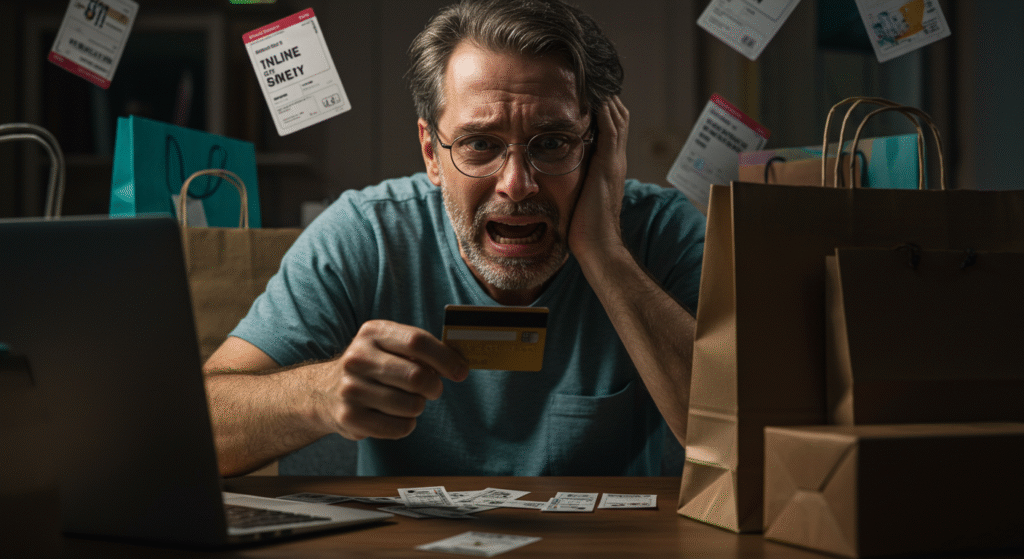Emotional spending sneaks into our lives more often than we realize, making bills and budgets feel out of reach. It’s not just about money; it’s also about the way we handle stress, loneliness, or a rough day. I’ve seen how this habit quietly chips away at both finances and emotional health, leaving many feeling stuck in a cycle of impulse buys and regret.
Stopping emotional spending isn’t about willpower alone. It requires understanding these patterns and learning new ways to respond to triggers that push us toward unnecessary purchases. In this article, I’m sharing practical strategies that go beyond quick fixes to help you regain control of your money and mood for good. You’ll find clear steps to recognize emotional spending, reduce its hold, and build habits that protect your well-being over the long term.
Recognizing Emotional Spending Patterns

Emotional spending is often hidden beneath everyday shopping choices, quietly steering us away from our financial goals. To stop emotional spending for good, you first need to understand why it happens and then identify the personal triggers that lead you to reach for your wallet. This awareness creates the foundation for real change and lasting control over your money.
Understanding Why We Spend Based on Emotions
Spending isn’t always about buying what we need. Sometimes, it’s about how we feel. When emotions like stress, loneliness, or boredom hit, reaching for a purchase can feel like a quick fix. Psychologically, emotional spending serves as a temporary escape or a way to soften unpleasant feelings.
Here’s why emotions play a big role in spending:
- Stress relief: Buying something new releases dopamine, the brain’s “feel-good” chemical, which can briefly lift mood during stressful times.
- Instant gratification: In a world that rewards instant access, shopping provides immediate satisfaction that feels like solving a problem right away.
- Loneliness or boredom: Spending becomes a comfort or distraction when social connection or meaningful activities are missing.
- Self-reward: After a hard day or accomplishment, purchases act as a way to celebrate or “treat” yourself.
- Social influence: Advertising and peer pressure tap into emotional desires for acceptance or status.
Emotional spending creates a loop: the temporary high fades, leaving you with consequences like bills or guilt, which can trigger more emotional purchases. Understanding these psychological drivers helps you recognize that spending is often less about money and more about managing feelings.
Identifying Your Own Triggers and Habits
Everyone has unique spending patterns and emotional triggers. Spotting yours requires a little detective work and honest reflection. Here’s how to start:
- Keep a spending and mood journal: Record every purchase along with what you felt right before buying. Look for connections like anxiety before shopping or sadness that led to impulse buys.
- Notice the when and where: Pay attention to times of day, locations, or situations that prompt spending (like late-night online browsing or shopping after arguments).
- Look at emotional states: Identify recurring feelings like loneliness, stress, or excitement that precede purchases.
- Spot common scenarios: Are you shopping after work, when you feel bored, or after scrolling social media?
- Reflect on past regretted purchases: What was happening emotionally underneath those decisions?
By mapping your personal triggers, you can catch yourself before reaching for a purchase to fix an emotion. Awareness is your best weapon against emotional spending. When you know your patterns, you create space to pause, breathe, and make intentional choices — a crucial step in learning how to stop emotional spending for good.
Practical Steps to Stop Emotional Spending

When emotions and money mix, it’s easy to lose track of where your finances are headed. Luckily, stopping emotional spending isn’t about shutting off feelings, but about putting simple, effective habits in place that slow down impulse and give you control. The practical steps below are designed to help you pause, plan, and respond more thoughtfully to spending urges, so your money supports your goals and your well-being.
Implementing the 24-Hour Rule and Spending Delays
One of the most straightforward tricks I use to catch emotional spending is the 24-hour rule. The idea is simple: when you feel the urge to buy something impulsively, wait at least 24 hours before making the purchase. That pause creates a mental buffer between the initial emotional trigger and the actual spending.
Why does this work? Our emotions tend to be strongest in the moment and then fade. When you give yourself time, the emotional urge often cools off, allowing your logical mind to step in and question if you really need the item or if it was just a reaction to stress or boredom. Sometimes, just a day is enough to realize the purchase isn’t that important after all.
Delays don’t need to stop at 24 hours either. For bigger purchases, I’ll extend the waiting period to a few days or even a week. It’s like giving your financial decisions a “cooling off” period so they don’t hijack your budget.
Practical tips to apply this:
- Set reminders on your phone to delay purchases.
- Remove items from your online cart and let them sit overnight.
- If you’re shopping in-store, walk away and revisit after a day.
- Make the rule clear for yourself and practice it consistently.
Creating Emotional Budgets and Spending Limits
Emotional spending often fills needs that aren’t just financial: companionship, joy, or self-care. Completely cutting off spending can backfire, so instead, I suggest creating an emotional budget—an amount you allocate for discretionary purchases that soothe your feelings without derailing your financial goals.
This means setting a clear limit on non-essential spending that feels comfortable and fair. By putting this budget in writing, you give yourself permission to spend within boundaries, avoiding guilt and all-or-nothing thinking.
How to build an emotional budget:
- Review your monthly income and fixed expenses.
- Decide on a reasonable amount for “comfort spending” like hobbies, treats, or social outings.
- Stick to that allowance even on emotional days, treating it like a spending goal rather than an open tab.
- Track this spending separately to stay aware and avoid crossing limits unnoticed.
Setting spending limits acts like guardrails for your emotions you acknowledge your needs without letting them control your wallet.
Using Cash and Budgeting Tools to Track Expenses
I’ve found that spending cash makes the impact of purchases much clearer. Handing over physical money instead of swiping a card slows you down and forces you to think twice. When you physically see the bills leave your wallet, it creates a stronger awareness of your spending less room for mindless buys.
If carrying cash feels inconvenient, budgeting apps offer another solid option. Tools like Mint, YNAB, or PocketGuard give real-time insight into where your money goes. They allow you to categorize expenses, set limits, and get alerts before you overspend.
Here’s how to use these tools effectively:
- Withdraw a fixed amount of cash monthly for discretionary spending.
- Use budgeting apps to log every purchase immediately.
- Review your spending patterns weekly to spot emotional shopping triggers.
- Set up notifications for when you’re nearing budget limits.
Awareness is key. When you track spending closely, you’ll find that the urge to impulsively buy loses strength because every purchase feels more deliberate.
Finding Healthy Emotional Alternatives
The root of emotional spending is the need to fulfill feelings — boredom, stress, loneliness, or reward. Replacing the shopping habit with healthier, cost-free ways to address these emotions is critical.
A few alternatives I recommend:
- Engage in hobbies: Find joy in creative outlets like drawing, cooking, or gardening that keep your hands busy and mind satisfied.
- Exercise regularly: Physical activity releases endorphins, improving mood naturally without the financial cost.
- Connect socially: Call a friend, join a community group, or spend time with family instead of reaching for a purchase.
- Practice mindfulness: Meditation or journaling can help you recognize emotional triggers and cope without buying.
- Get outside: Nature walks or fresh air provide calm and distraction from spending impulses.
Replacing the “shop to feel better” reflex with these options rewires your habits. Over time, your emotional needs will stop pushing you toward the checkout.
Taking these practical steps helps me, and anyone struggling with emotional spending, to break the cycle. They aren’t about avoiding emotions but about respecting both your feelings and your financial health. When you build in these habits, spending becomes a choice made with care instead of a reaction to mood. This balance is key to knowing how to stop emotional spending for good.
Building Long-Term Financial and Emotional Resilience

Stopping emotional spending for good goes beyond just resisting the urge in the moment. It’s about creating a strong foundation that supports both your financial stability and emotional well-being over time. Building long-term resilience means learning to handle stress and setbacks without turning to impulse buying as a quick fix. It’s about understanding your feelings, staying motivated with clear goals, and surrounding yourself with the right support. This sense of balance and control plays a huge role in breaking free from emotional spending patterns.
Developing Mindfulness and Emotional Awareness
Becoming aware of your emotions and how they influence spending is a game changer. Mindfulness and emotional intelligence are tools that help you catch yourself before buying in response to a fleeting mood. When you practice mindfulness, you learn to notice your feelings without judgment and pause before reacting to them.
Simple practices like taking a few deep breaths before reaching for your wallet or checking in with yourself about why you want to make a purchase can create that crucial moment of reflection. Over time, this reflection builds emotional awareness.
Here are some ways to develop mindfulness around spending:
- Start a daily check-in: Spend a minute or two noticing how you feel. Are you stressed, lonely, or bored? Recognize these feelings as they come.
- Label your emotions: Give your feelings a name like “anxiety” or “fatigue.” Naming emotions reduces their power.
- Practice breathing exercises: Use a few slow, deep breaths when you feel the urge to spend impulsively.
- Journal your experience: Writing about what you feel before and after spending reveals patterns you might miss.
By becoming more mindful, you gain the ability to separate your desire to spend from the emotions fueling it. This puts you back in control instead of being driven by impulse.
Seeking Support and Accountability
Facing emotional spending alone can feel overwhelming. I’ve found that sharing your goals and progress with others creates motivation and helps keep you honest. Support doesn’t mean someone else controls your choices. Instead, it’s about having allies who understand your challenges and encourage you to stick to your plans.
Friends, family members, or professionals like financial coaches or therapists can provide valuable accountability. They offer perspective when your emotions cloud your judgment, and they celebrate your wins with you.
Ways to build support and accountability:
- Tell a trusted friend or family member about your goals. Ask them to check in regularly.
- Join support groups or online communities focused on managing money mindfully.
- Schedule regular meetings with a financial coach or counselor. They help identify emotional triggers and plan strategies.
- Create accountability rituals, like weekly spending reviews with your partner or a friend.
Knowing someone else is aware of your journey makes slipping back into emotional spending less likely. Support becomes a safety net that boosts your confidence and resilience.
Planning for Future Rewards Instead of Instant Gratification

Emotional spending often comes from craving instant happiness or relief. The problem is this quick fix fades fast, leaving behind guilt or financial strain. Shifting your focus toward future rewards helps break that cycle by giving your spending meaning and purpose.
When you start imagining how saving money or sticking to your budget opens doors to goals you actually care about, spending impulsively loses its appeal. You trade short-term pleasure for bigger, lasting satisfaction.
Here’s how to plan for future rewards:
- Set clear, inspiring financial goals. Whether it’s a vacation, debt freedom, or building an emergency fund, write them down and visualize them often.
- Break big goals into smaller milestones. Celebrate these mini wins with non-spending rewards like time with friends or a favorite activity.
- Remind yourself daily why those goals matter. Place photos or notes in visible spots.
- Use budgeting tools that highlight progress. Watching your savings grow replaces the thrill of impulse buys.
- Create “delayed purchase” lists. When you want to buy something impulsively, add it to the list and revisit in a week or month.
Refocusing on long-term benefits rewires your brain to value delayed rewards. This changes emotional spending from a knee-jerk reaction into a choice made with intention and care.
When you combine mindfulness, support, and forward-looking goals, you start to build a resilient foundation that protects both your money and your emotional health. This foundation is what makes stopping emotional spending feel less like a battle and more like a natural part of living well.
Conclusion
Stopping emotional spending for good starts with understanding what drives it and recognizing your own triggers. Awareness creates the space needed to make thoughtful decisions instead of reacting to feelings in the moment.
Applying practical strategies like the 24-hour rule, setting clear budgets, and tracking expenses helps you slow down impulsive purchases and regain control. Replacing spending with healthy emotional alternatives supports lasting change.
Building support through friends, accountability partners, or professionals strengthens your efforts and keeps you motivated. When you focus on future goals instead of instant gratification, your spending aligns with your values.
By combining awareness, smart habits, and connection, I’ve seen how anyone can break free from emotional spending and create a balanced relationship with money and emotions. Take these steps today, and you’ll find a stronger sense of freedom and well-being that lasts.




